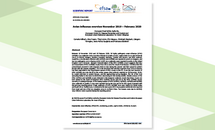Avian influenza overview June–September 2023
This report provides an overview of highly pathogenic avian influenza (HPAI) virus detections in poultry, captive and wild birds that occurred in and outside Europe between 24 June and 1 September 2023, as well as HPAI virus detections in mammals (up to 15 September 2023) and human cases due to avian influenza virus (up to 14 September 2023).
Executive Summary
Between 24 June and 1 September 2023, highly pathogenic avian influenza (HPAI) A(H5) outbreaks were reported in domestic (25) and wild (482) birds across 21 countries in Europe. Most of these outbreaks appeared to be clustered along coastlines with only few HPAI virus detections inland.
In poultry, all HPAI outbreaks were primary and sporadic with most of them occurring in the United Kingdom. In wild birds, colony-breeding seabirds continued to be most heavily affected, but an increasing number of HPAI virus detections in waterfowl is expected in the coming weeks.
The current epidemic in wild birds has already surpassed the one of the previous epidemiological year in terms of total number of HPAI virus detections.
As regards mammals, A(H5N1) virus was identified in 26 fur animal farms in Finland. Affected species included American mink, red and Arctic fox, and common raccoon dog. The most likely source of introduction was contact with gulls. Wild mammals continued to be affected worldwide, mostly red foxes and different seal species.
Since the last report and as of 28 September 2023, two A(H5N1) clade 2.3.4.4b virus detections in humans have been reported by the United Kingdom, and three human
infections with A(H5N6) and two with A(H9N2) were reported from China, respectively. No human infection related to the avian influenza detections in animals on fur farms in Finland or in cats in Poland have been reported, and human infections with avian influenza remain a rare event.
The risk of infection with currently circulating avian H5 influenza viruses of clade 2.3.4.4b in Europe remains low for the general population in the EU/EEA. The risk of infection remains low to moderate for occupationally or otherwise exposed people to infected birds or mammals (wild or domesticated); this assessment covers different situations that depend on the level of exposure.
Download








